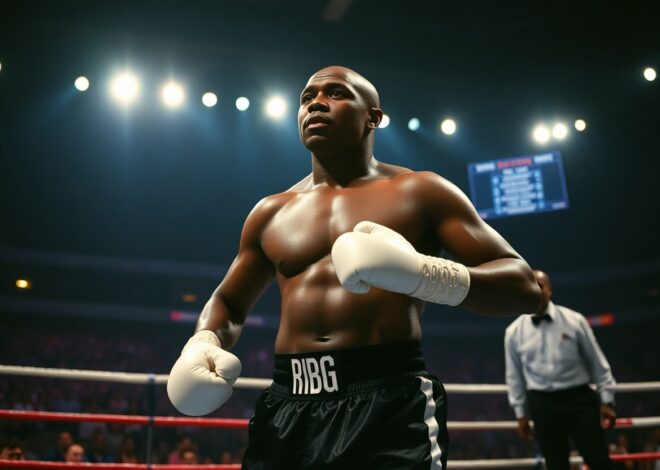
10 Timeless Lessons We Can Learn From Boxing Legends
Legends of the ring offer valuable insights that extend beyond the sport itself. These fearless athletes embody principles such as resilience, discipline, and strategy, all of which can inspire us in our everyday lives. By examining their journeys and the challenges they faced, we can extract lessons on perseverance and the importance of hard work. This guide explores ten enduring lessons that not only shaped their careers but can also empower us to achieve our own goals.
Types of Boxing Legends
- Heavyweight Champions
- Light and Middleweight Icons
- Female Pioneers
- Knockout Artists
- Defensive Masters
Thou can see that each type of boxing legend brings unique skills to the ring.
| Category | Examples |
| Heavyweight Champions | Mike Tyson, Muhammad Ali |
| Lightweight Fighters | Sugar Ray Leonard, Oscar De La Hoya |
| Middleweight Icons | Marvin Hagler, Bernard Hopkins |
| Female Pioneers | Christy Martin, Laila Ali |
| Knockout Artists | Joe Frazier, Deontay Wilder |
Heavyweight Champions
Heavyweight champions like Mike Tyson and Muhammad Ali have defined boxing with their remarkable power and charisma. Tyson became the youngest heavyweight champion at 20, known for his ferocious knockouts, while Ali’s agility and technique revolutionized the sport. Through their rivalries and triumphs, they left an indelible mark on boxing history, demonstrating that strength and strategy can coexist at the sport’s pinnacle.
Light and Middleweight Icons
Light and middleweight icons exemplify technical excellence and speed. Boxers like Sugar Ray Leonard and Marvin Hagler showcased not only skill but also outstanding endurance in their bouts. Their ability to adapt to opponents’ styles and deliver powerful punches make them exemplary figures in boxing lore. This category often bridges the gap between raw talent and masterful tactics, enhancing the sport’s legacy.
Many light and middleweight icons, such as Leonard and Hagler, redefined their weight classes with a blend of speed and strategy. Their battles often highlighted the importance of footwork and stamina, as seen in the “Fight of the Century” between Leonard and Hagler. This level of competition ensured that these fighters were not only skilled punchers but also exceptional tacticians, demonstrating the complexity and artistry inherent in boxing.
Key Tips for Success in Boxing
To achieve greatness in boxing, several key strategies emerge as vital for aspiring fighters. Focus on technique, maintain a rigorous training schedule, and prioritize nutrition. Develop a strong mental game and embrace a resilient mindset. Lastly, adapt to your opponent’s style while continually refining your own. Knowing the right combination of skills and strategies can lead to a successful boxing career.
Mental Toughness
Mental toughness plays a pivotal role in boxing, as fighters face immense pressure and challenges. Prominent boxers, like Mike Tyson, often credit their mental resilience for overcoming fear and self-doubt. Techniques such as visualization, positive self-talk, and goal setting empower fighters to remain focused and composed under stress. Instilling a mindset that welcomes adversity can set champions apart.
Physical Conditioning
Physical conditioning is fundamental in boxing, shaping a fighter’s ability to endure grueling matches. Elite athletes implement strength training, cardio workouts, and stretching routines to enhance their performance. Fighters typically spend numerous hours each week on conditioning workouts to build necessary stamina, speed, and agility. Moreover, honing footwork and reflexes is vital for avoiding punches and launching counterattacks effectively.
Developing a tailored conditioning plan is vital for peak performance. Boxers often follow a mixed regimen, incorporating exercises like running, sparring, and interval training. For instance, former champion Floyd Mayweather Jr. relied on jump rope routines to improve footwork, while also emphasizing the importance of maintaining a strict diet. This comprehensive approach ensures fighters not only build muscle but also prepare their bodies for the specific demands of the sport, enhancing endurance and reducing injury risk.
Step-by-Step Approach to Mastering Boxing Skills
Mastering Boxing Skills
| Step | Description |
| 1. Warm Up | Engage in dynamic stretches and light cardio to prepare muscles for training. |
| 2. Basic Techniques | Focus on fundamental punches, footwork, and defensive maneuvers. |
| 3. Shadow Boxing | Practice combinations and movement without a partner or bag. |
| 4. Sparring | Apply skills in a controlled environment against an opponent. |
| 5. Review & Adjust | Analyze performance and refine techniques based on feedback. |
Basic Techniques
Mastering the basic techniques is vital for any boxer. This includes proper stance, balance, and delivering punches like jabs, crosses, hooks, and uppercuts. Using an effective guard can protect against incoming blows. Consistently practicing these skills builds foundational strength and enhances performance, ensuring lasting improvement and confidence in the ring.
Advanced Strategies
Advanced strategies elevate a boxer’s performance, incorporating concepts like feints, counterpunching, and ring generalship. Boxers learn to anticipate their opponent’s moves, creating openings to exploit while minimizing their vulnerabilities. Analyzing opponents’ styles and adjusting tactics accordingly is key to gaining a competitive edge.
- Utilize feints to disrupt your opponent’s rhythm.
- Practice counterpunching to capitalize on mistakes.
- Master footwork for effective movement and positioning.
- Study fighters’ habits for tactical adjustments.
Advanced Strategies Expanded
| Strategy | Details |
| Feints | Creating uncertainty in opponents can lead to mistakes; boxers must practice deceptive movements. |
| Counterpunching | Staying alert to capitalize on openings immediately following an opponent’s attack; precise timing is crucial. |
| Ring Generalship | Controlling the pace and positioning in the ring is vital for exploiting advantages; always stay one step ahead. |
- Enhance prediction skills through consistent analysis.
- Develop adaptability to shift strategies mid-fight.
- Incorporate situational drills to simulate real fight scenarios.
Essential Factors Influencing a Boxer’s Career
Various factors shape a boxer’s career trajectory, impacting their performance and longevity in the sport. Some of the crucial elements include:
- Training environment
- Support system
- Physical conditioning
- Mental resilience
- Coaching quality
After considering these elements, fighters can devise strategies to optimize their training and performance.
Training Environment
The training environment plays a pivotal role in a boxer’s development. Access to top-notch facilities, sparring partners, and coaching can significantly enhance skills and techniques. A positive atmosphere fosters growth, allowing boxers to push their limits and refine their strategies.
Support System
A solid support system can greatly influence a boxer’s success. Family, friends, coaches, and mentors provide encouragement, motivation, and guidance throughout the journey. Having a reliable team creates a foundation of stability, crucial for overcoming the mental and physical challenges faced in boxing.
Support systems often extend beyond immediate circles. Successful boxers like Manny Pacquiao have highlighted the impact of community backing in their careers. Training camps that include psychological support and open communication with trainers foster resilience and focus. A well-rounded network can lead to improved performance and greater achievements in the ring.
Pros and Cons of Boxing as a Sport
| Pros | Cons |
|---|---|
| Improves Fitness: Enhances cardiovascular health, strength, and endurance. | Injury Risk: High potential for concussions and other serious injuries. |
| Discipline: Cultivates mental resilience and focus. | Short Career Span: Most boxers have brief professional lifespans due to wear and tear. |
| Self-Defense Skills: Teaches effective self-defense techniques. | Weight Control: Pressure to maintain specific weight classes can lead to unhealthy practices. |
| Community: Fosters camaraderie among boxers and fans. | Social Stigma: Often viewed negatively for its violent nature. |
| Career Opportunities: Can lead to various jobs in fitness, coaching, and commentary. | Financial Instability: Earnings can be inconsistent and heavily reliant on fight outcomes. |
Benefits of Boxing
Boxing offers numerous benefits beyond the ring. It enhances physical fitness through intensive workouts that improve strength, agility, and endurance. Participants develop discipline and focus, crucial for mastering techniques and strategies. The sport also fosters a sense of community, as training often occurs in supportive environments with camaraderie among peers. Furthermore, boxing equips individuals with valuable self-defense skills that promote personal safety.
Risks Involved
While boxing provides various benefits, it also presents significant risks that cannot be ignored. The sport’s nature subjects participants to potential injuries, particularly brain damage and concussions, which can have long-term effects. Athletes often face intense physical demands, leading to injuries ranging from fractures to strains and overuse issues.
Injuries in boxing vary in severity and frequency. Studies indicate that around 20% of professional boxers experience concussions during their careers. Additionally, long-term exposure to repetitive head trauma is linked to chronic traumatic encephalopathy (CTE), a degenerative brain condition. The physical toll of the sport may also lead to issues like joint pain and chronic injuries, emphasizing the importance of proper training, protective gear, and medical oversight in mitigating these risks.
Life Lessons from Boxing Legends
Boxing legends embody life lessons that extend beyond the ring. Their journeys showcase the value of hard work, mental fortitude, and the importance of overcoming adversity. Each champion’s story serves as a reminder that success often requires enduring hardship and unwavering commitment. By analyzing their paths, we can extract the important qualities that not only define a great boxer but also contribute to personal growth and achievement in all areas of life.
Perseverance and Resilience
Perseverance and resilience were hallmarks of champions like Mike Tyson and Muhammad Ali, who faced numerous setbacks yet found the strength to rise again. Tyson, for example, overcame a tumultuous childhood and multiple career lows, showcasing that true grit often comes from the depths of struggle. This relentless spirit serves as a powerful lesson in maintaining focus and determination despite life’s challenges.
Discipline and Focus
The discipline and focus displayed by boxing legends are fundamental to their success. Floyd Mayweather is renowned for his strict training regimen and diet, often adhering to a schedule that would seem daunting to many. This level of commitment allows boxers to hone their skills continually and maintain peak performance levels. It emphasizes the importance of routine in achieving long-term goals.
Discipline in boxing goes beyond mere physical training; it encompasses a mental commitment to excellence. Legends such as Joe Louis dedicated hours to refining their techniques and studying opponents meticulously. This unwavering focus not only cultivates superior skills but also sharpens a boxer’s decision-making during high-pressure moments. By prioritizing consistent training and maintaining a laser-like focus on their goals, boxers exemplify how discipline can lead to extraordinary outcomes, far surpassing the average pursuit of excellence.
Summing up
Conclusively, the ten timeless lessons from boxing legends highlight the importance of discipline, resilience, and strategy in both sports and life. By studying the philosophies and practices that propelled these athletes to greatness, individuals can glean insights into managing challenges, setting and achieving goals, and fostering a winning mindset. These principles transcend the ring, offering valuable guidance applicable to various personal and professional endeavors, ensuring that the legacy of boxing continues to inspire future generations.
FAQ
Q: What are some key lessons from Muhammad Ali’s boxing career?
A: Muhammad Ali taught us the importance of self-belief, perseverance, and social responsibility. His ability to maintain confidence in the face of adversity and his commitment to fighting for justice outside of the ring are invaluable lessons.
Q: How can the discipline of boxing be applied to everyday life?
A: The discipline of boxing emphasizes commitment, focus, and rigorous training for success. These principles can be applied to personal and professional goals, showcasing the value of hard work and dedication in achieving one’s aspirations.
Q: What is the significance of resilience in the teachings of boxing champions?
A: Resilience is a core lesson from boxing legends, highlighting the ability to bounce back from setbacks. Their experiences demonstrate that failures and challenges are opportunities for growth, inspiring us to stay strong and keep pushing forward despite obstacles.



